Protocol for the Analysis of Cross-Sections from Gilded Surfaces
Abstract
:1. Introduction
- How many gilding schemes are there (i.e., how many times has an object been re-gilded)?
- What type of gilding is it (e.g., oil gilding, water gilding, mercury gilding, electroplating, etc.)?
- What period is each individual gilding scheme from?
- What is the stratigraphy and composition of the layers within each gilding scheme?
2. Materials and Methods
2.1. The Protocol
- Sampling;
- Stereo microscopy of loose samples;
- Optical microscopy of samples mounted as cross-sections;
- Micro X-ray fluorescence (μXRF);
- Elemental mapping by scanning electron microscopy with energy-dispersive X-ray analysis (SEM–EDX);
- Raman microscopy;
- Micro X-ray diffraction (μXRD);
- Separation techniques for binding media and other organic materials (dyes, etc.);
- Fourier-transform infrared analysis (FTIR).
- Step 1—Sampling
- Step 2—Stereo microscopy
- Step 3—Optical microscopy of cross-sections
- It reveals the full layer structure;
- It confirms, at a glance, how many gilding applications are present;
- It shows if gold leaf or gold paint (‘shell gold’) or silver have been used, or if a cheaper imitation is present, such as tin, brass or bronze leaf, filings or paint;
- It gives a good preliminary indication of whether water gilding, oil gilding, or both are present;
- It provides information on the shape and size of particles in each layer
- It allows for a preliminary estimate of the composition of many of the layers.
- Step 4—Micro X-ray fluorescence (μXRF)
- Step 5—Elemental mapping by scanning electron microscopy with energy-dispersive X-ray analysis (SEM–EDX)
- It reveals most of the layer structure;
- It confirms at a glance how many gilding applications are present;
- It clearly identifies what type of metallic material (gold, gold imitation or silver) and morphology (leaf, filings, powder, etc.) are present in the gilding layers;
- It shows if any of the older gilding layers are worn out, damaged or corroded;
- It suggests what mixtures of pigments and artists’ materials may be present in each layer (with possible dating implications);
- It provides sharp, high resolution information on the shape, distribution and size of particles in the layers.
- Step 6—Raman microscopy
- The molecular characterisation of individual particles;
- The identification of corrosion or other degradation products.
- Step 7—Micro X-ray diffraction (μXRD)
- Step 8—Separation techniques (chromatography)
- Step 9—Fourier-transform infrared microscopy
2.2. Experimental Conditions
3. Results—The Protocol in Action
3.1. How Many Gilding Schemes Are There (i.e., How Many Times Has an Object Been Re-gilded)?
3.2. What Type of Gilding Is It?
3.3. What Period Is Each Individual Gilding Scheme from?
3.4. What Is the Stratigraphy and Composition of the Layers within Each Gilding Scheme?
3.4.1. Metal Finish
3.4.2. Preparation Layers
4. Conclusions
Author Contributions
Funding
Data Availability Statement
Acknowledgments
Conflicts of Interest
References
- Cleaning of Wooden Gilded Surfaces. Available online: https://www.getty.edu/conservation/publications_resources/pdf_publications/pdf/cleaning-wooden-gilded-surfaces.pdf (accessed on 25 July 2021).
- Powell, C.; Mallinson, F.; Allen, Z. Overview of the gilded objects treated for the British Galleries. V A Conserv. J. 2001, 39, 10–11. [Google Scholar]
- Allen, Z.; Wegwitz, L. The two make a pair: Differentiated treatment of a pair of gilded stools displayed in the furniture gallery at the V&A. In Conserving Context—Relating Object Treatment to Collections and Settings; Alabone, G., Ed.; Archetype Books: London, UK, 2015. [Google Scholar]
- Pinna, D.; Claudia Conti, C.; Mazurek, J. Polychrome sculptures of medieval Italian monuments: Study of the binding media and pigments. Microchem. J. 2020, 158, 105100. [Google Scholar] [CrossRef]
- Darque-Ceretti, E.; Felder, E.; Aucouturier, M. Foil and leaf gilding on cultural artifacts; forming and adhesion. Rev. Matér. 2011, 16, 540–559. [Google Scholar] [CrossRef]
- Osticioli, I.; Capozzoli, L.; Salvadori, B.; Banchelli, M.; Lavacchi, A.; Matteini, P.; Siano, S.; Gallo, L. The “oro di metà” Gilding in the Fifteenth-Century: A Multi-Analytical Investigation. Heritage 2019, 2, 1166–1175. [Google Scholar] [CrossRef] [Green Version]
- Crina Anca Sandu, I.; de Sá, M.H.; Pereira, M.C. Ancient ‘gilded’ art objects from European cultural heritage: A review on different scales of characterization. Surf. Interface Anal. 2011, 43, 1134–1151. [Google Scholar] [CrossRef]
- Gard, F.S.; Daizo, M.B.; Santos, D.M.; Halac, E.B.; Freire, E.; Reinoso, M.; Montero, R.J. Application of surface science techniques to study a gilded Egyptian funerary mask: A multi-analytical approach. Surf. Interface Anal. 2019, 51, 1001–1017. [Google Scholar] [CrossRef]
- Chao, R.; Heginbotham, A.; Lee, L.; Chiari, G. Materials and techniques of gilding on a suite of French eighteenth-century chairs. Stud. Conserv. 2014, 59, 102–112. [Google Scholar] [CrossRef]
- Gilding. Available online: https://www.rct.uk/collection/conservation/gilding (accessed on 25 July 2021).
- How Was It Made? Water Gilding. Available online: http://www.vam.ac.uk/content/videos/w/video-water-gilding/ (accessed on 25 July 2021).
- Plesters, J. Cross-sections and Chemical Analysis of Paint Samples. Stud. Conserv. 1956, 2, 110–157. [Google Scholar] [CrossRef]
- Burgio, L. V&A Internal Analysis Report 20-16-LB; V&A: London, UK, 2020. [Google Scholar]
- Burgio, L. V&A Internal Analysis Report 17-04-LB; V&A: London, UK, 2017. [Google Scholar]
- Burgio, L. “Under the Skin of the Spirit of Gaiety”, Part 1 to Part 5. Available online: https://www.vam.ac.uk/blog/author/lucia-burgio (accessed on 25 July 2021).
- Offord, S. “The Guardian Angel of Theatreland: A History of the Spirit of Gaiety”. Available online: https://www.vam.ac.uk/blog/news/the-guardian-angel-of-theatreland-a-history-of-the-spirit-of-gaiety (accessed on 28 July 2021).
- Analytical Methods Committee. Raman spectroscopy in cultural heritage: Background paper. Anal. Methods 2015, 7, 4844–4847. [Google Scholar] [CrossRef]
- Clark, R.J.H. Pigment identification by spectroscopic means: An arts/science interface. Comptes Rendus Chim. 2002, 5, 7. [Google Scholar] [CrossRef]
- Franquelo, M.L.; Duran, A.; Castaing, J.; Arquillo, D.; Perez-Rodriguez, J.J. XRF, μ-XRD and μ-spectroscopic techniques for revealing the composition and structure of paint layers on polychrome sculptures after multiple restorations. Talanta 2012, 89, 462–469. [Google Scholar] [CrossRef]
- Burgio, L.; Melchar, D.; Strekopytov, S.; Peggie, D.A.; Di Crescenzo, M.M.; Keneghan, B.; Clark, B.L. Identification, characterisation and mapping of calomel as ‘mercury white’, a previously undocumented pigment from South America, and its use on a barniz de Pasto cabinet at the Victoria and Albert Museum. Microchem. J. 2018, 143, 220–227. [Google Scholar] [CrossRef]
- Zhou, Z.; Shen, L.; Wang, N.; Ren, X.; Yang, J.; Shi, Y.; Zhang, H. Identification of Organic Materials Used in Gilding Technique in Wall Paintings of Kizil Grottoes. ChemistrySelect 2020, 5, 818–822. [Google Scholar] [CrossRef]
- Bonaduce, I.; Colombini, M.P.; Diring, S. Identification of garlic in old gildings by gas chromatography—Mass spectrometry. J. Chromatog. A 2006, 1107, 226–232. [Google Scholar] [CrossRef]
- Schilling, M.R.; Heginbotham, A.; van Keulen, H.; Szelewski, M. Beyond the basics: A systematic approach for comprehensive analysis of organic materials in Asian lacquers. Stud. Conserv. 2016, 61, 3–27. [Google Scholar] [CrossRef] [Green Version]
- Spring, M.; Ricci, C.; Peggie, D.A.; Kazarian, S.G. ATR-FTIR imaging for the analysis of organic materials in paint cross sections: Case studies on paint samples from the National Gallery, London. Anal. Bioanal. Chem. 2008, 392, 37–45. [Google Scholar] [CrossRef]
- Joseph, E.; Ricci, C.; Kazarian, S.G.; Mazzeo, R.; Prati, S.; Ioele, M. Macro-ATR-FT-IR spectroscopic imaging analysis of paint cross-sections. Vib. Spectrosc. 2010, 53, 274–278. [Google Scholar] [CrossRef]
- Bell, I.M.; Gibbs, P.J.; Clark, R.J.H. Raman spectroscopy library of natural and synthetic pigments (pre- ~1850AD). Spectrochim. Acta A 1997, 53, 2159–2179. [Google Scholar] [CrossRef]
- Burgio, L.; Clark, R.J.H. Library of FT-Raman spectra of pigments, minerals, pigment media and varnishes, and supplement to existing library of Raman spectra of pigments with visible excitation. Spectrochim. Acta A 2001, 57, 1491–1521. [Google Scholar] [CrossRef]
- RRUFF Database. Available online: http://rruff.info/ (accessed on 1 August 2020).
- IRUG, Infrared and Raman Users Group. Available online: http://www.irug.org/ (accessed on 1 June 2021).
- Risdonne, V.; Burgio, L.; Schilling, M.R.; Khanjian, H. Investigation of Burmese lacquer methods: Technical examination of the V&A Burmese shrine. J. Cult. Herit. 2018, 30, 16–25. [Google Scholar] [CrossRef]
- Risdonne, V.; Burgio, L.; Schilling, M.; Khanjian, H. Scientific Analysis of the V&A Burmese Shrine. Arts Asia 2017, 47, 56–62. [Google Scholar]
- Zhou, Z.; Shen, L.; Li, C.; Wang, N.; Chen, X.; Yang, J.; Zhang, H. Investigation of gilding materials and techniques in wall paintings of Kizil Grottoes. Microchem. J. 2020, 154, 104548. [Google Scholar] [CrossRef]
- Laver, M. Titanium Dioxide Whites. In Artists’ Pigments; West FitzHugh, E., Ed.; Oxford University Press: Oxford, UK, 1997; Volume 3, pp. 295–356. [Google Scholar]
- CAMEO Materials Database, Titanium White. Available online: http://cameo.mfa.org/wiki/Titanium_white (accessed on 3 August 2020).
- Eastaugh, N.; Walsh, V.; Chaplin, T.; Siddall, R. Pigment Compendium: A Dictionary of Historical Pigments; Routledge: Abingdon, UK, 2008; p. 320. [Google Scholar]
- Kühn, H.; Curran, M. Chrome yellow and other chromate pigments. In Artists’ Pigments; A Handbook of Their History and Characteristics; Feller, R.L., Ed.; Oxford University Press: Oxford, UK, 1986; Volume 1, pp. 187–217. [Google Scholar]
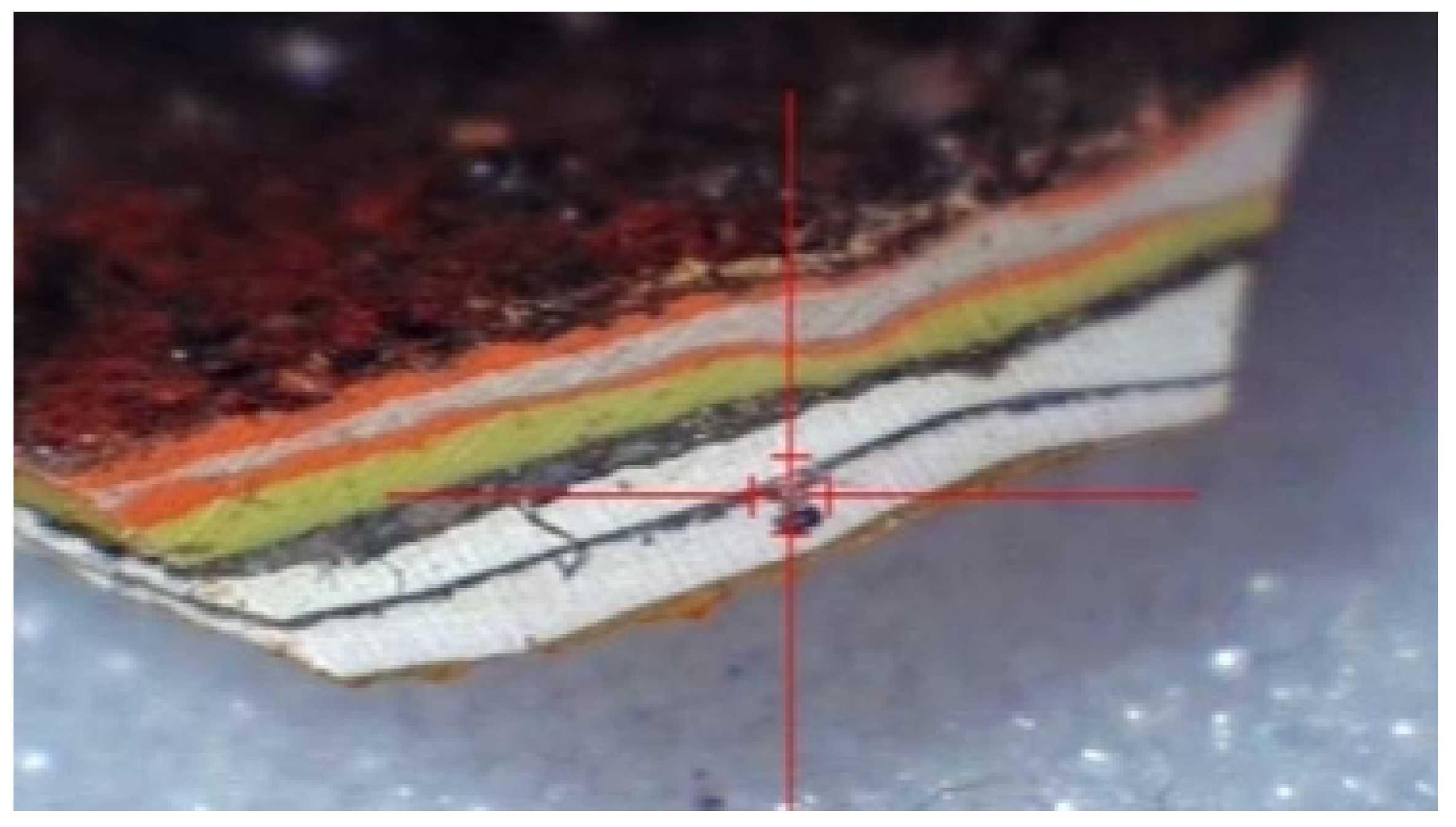



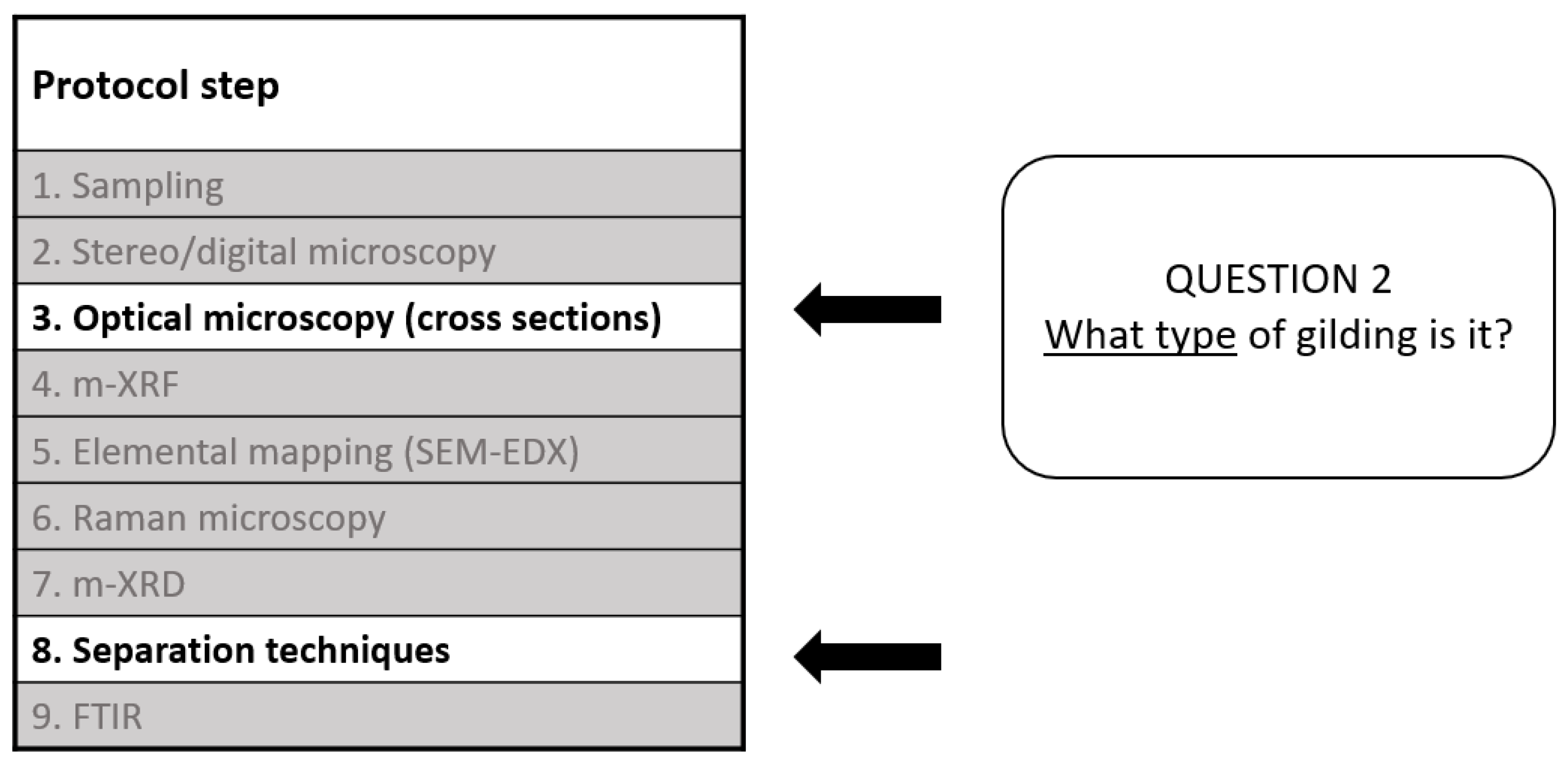

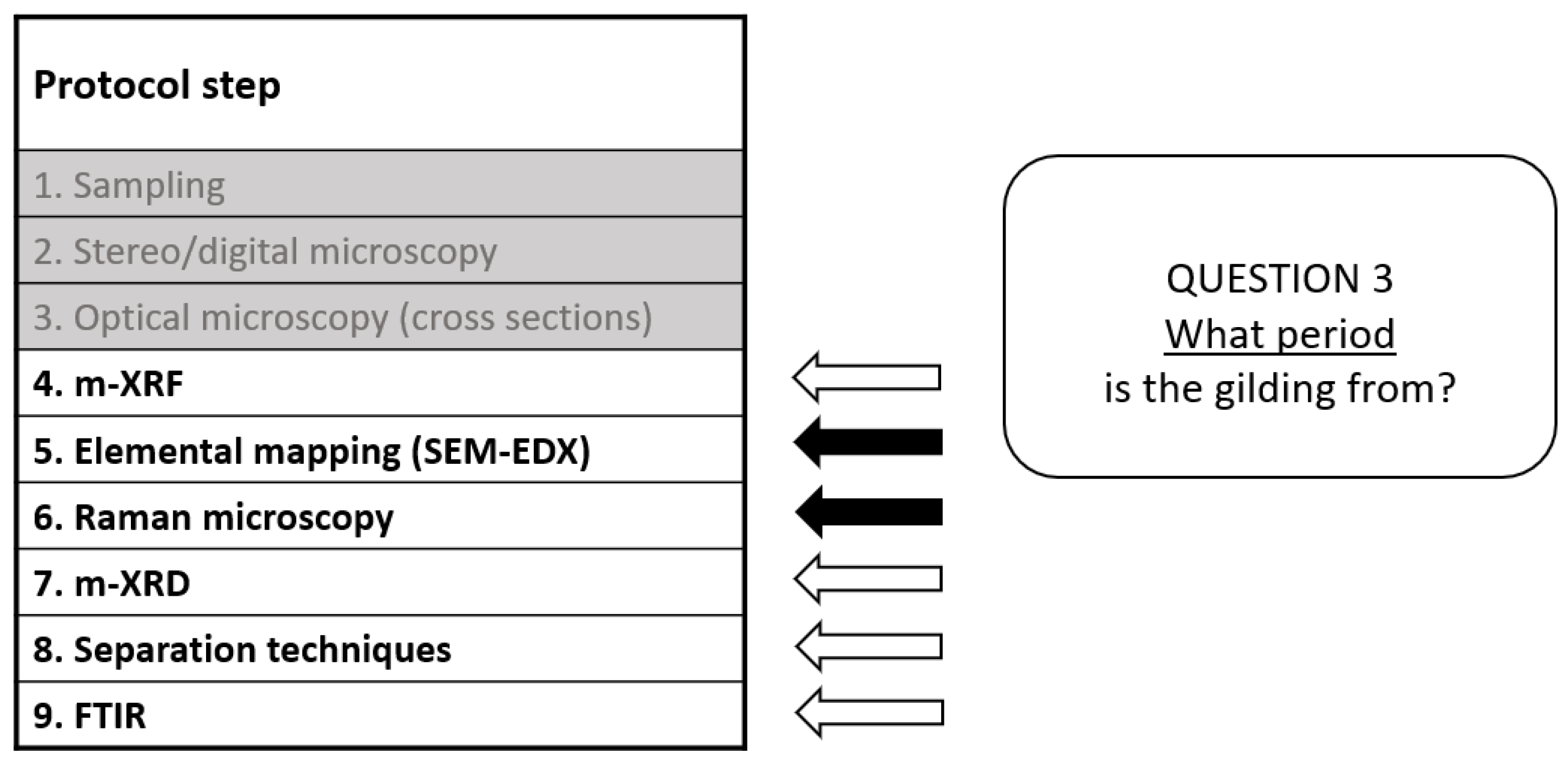


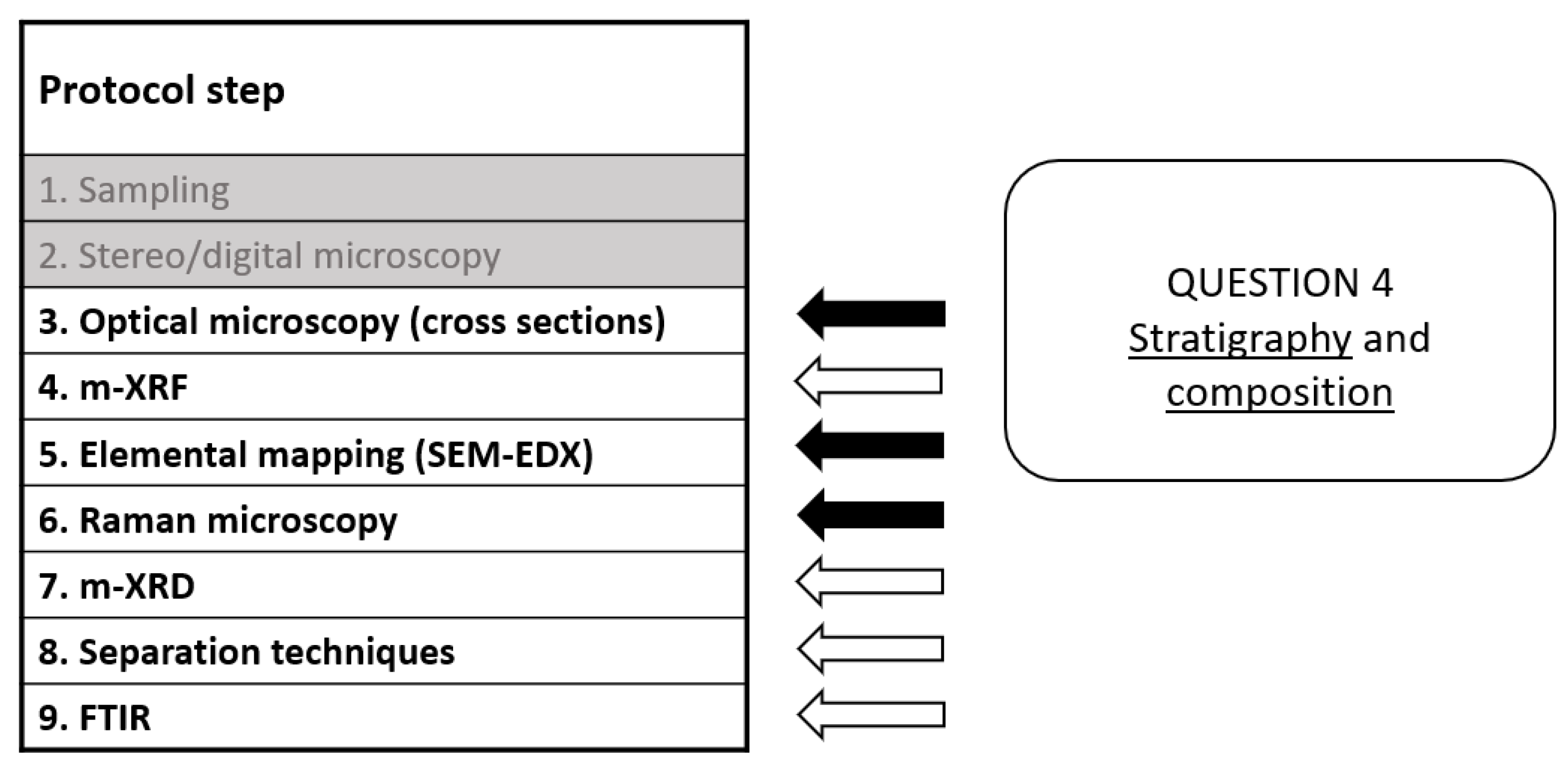
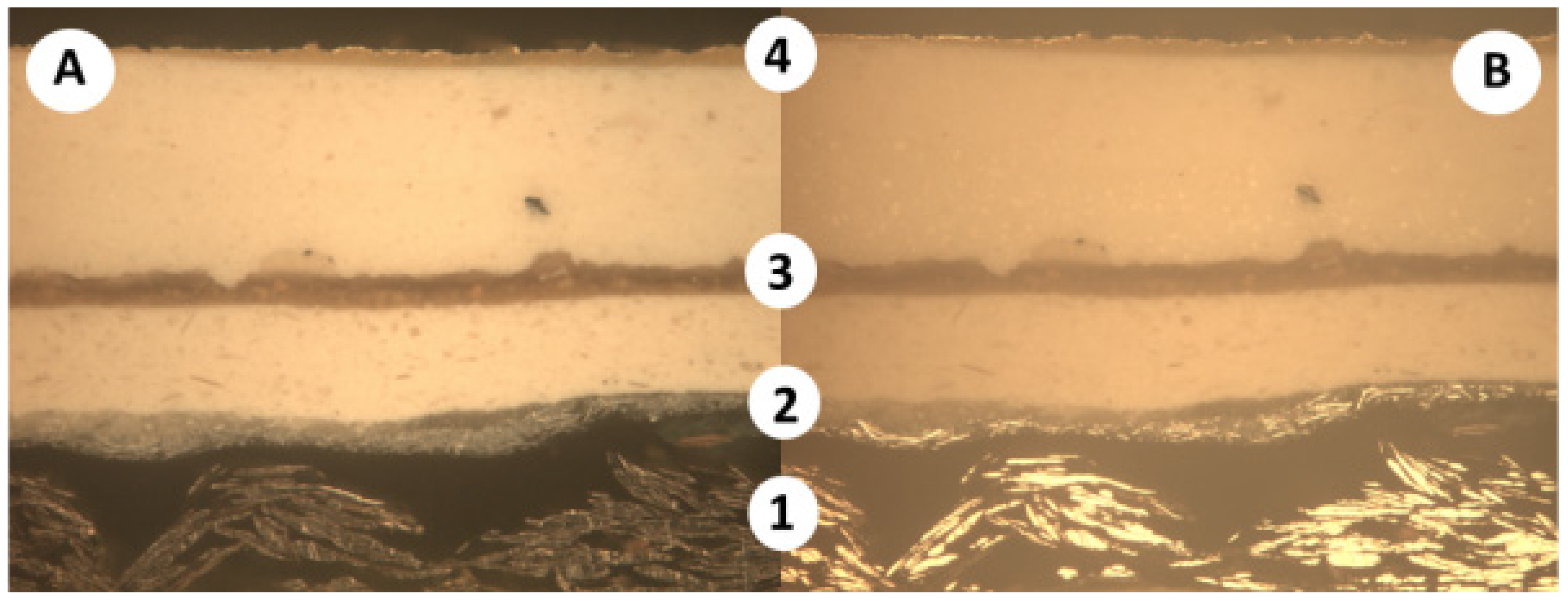
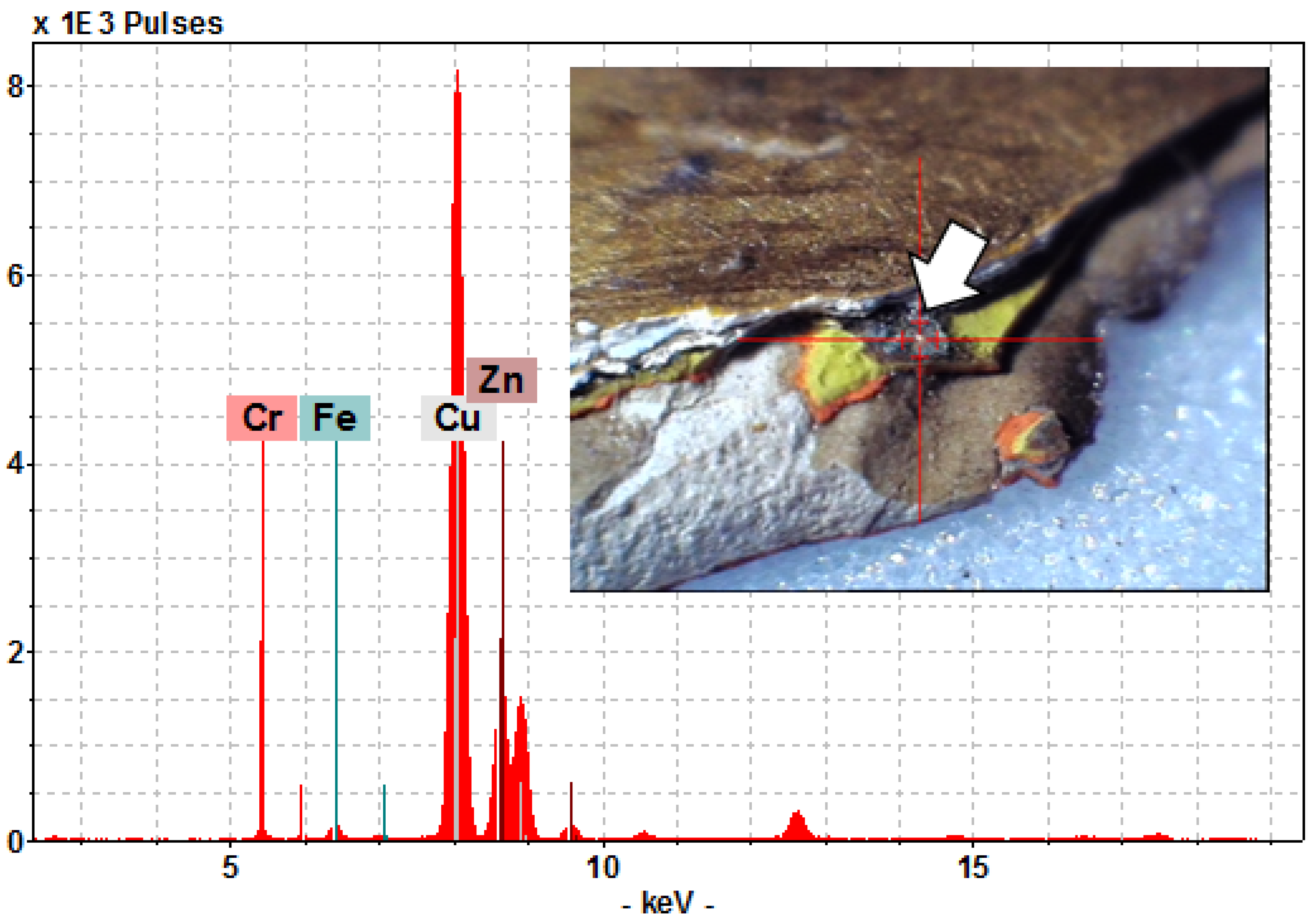
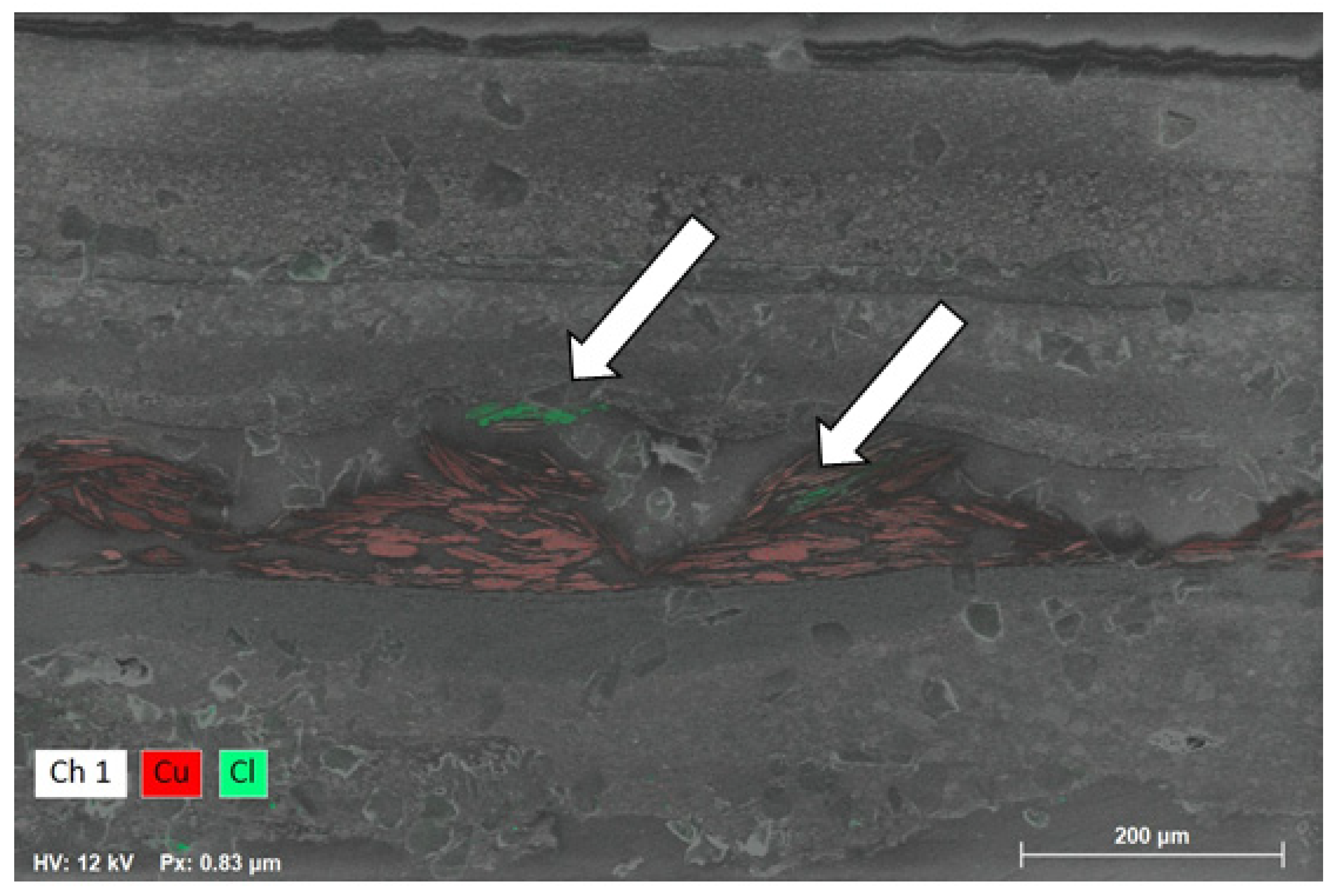

| Steps | ||||||||
|---|---|---|---|---|---|---|---|---|
| 2 | 3 | 4 | 5 | 6 | 7 | 8 | 9 | |
| Stereo Microscopy | Optical Microscopy | μXRF | SEM–EDX Mapping | Raman Microscopy | μXRD | Separation Techniques | FTIR | |
| Gilding: Number of schemes | (✓) | ✓ | ✓ | |||||
| Gilding: Metal composition | (✓) | (✓) | ✓ | |||||
| Gilding: Metal morphology | ✓ | ✓ | (✓) | |||||
| Gilding: Oil vs. water | ✓ | ✓ | ✓ | |||||
| Gilding: Corrosion products | (✓) | ✓ | (✓) * | |||||
| Layers: Full stratigraphy | (✓) | ✓ | ✓ | |||||
| Layers: Atomic composition | (✓) | ✓ | ||||||
| Layers: Molecular composition | (✓) | ✓ | ✓ * | (✓) | (✓) | |||
| Layers: Morphology of components | ✓ | ✓ | (✓) | |||||
| Layers: Binding medium | ✓ | ✓ | ||||||
| Layers: Organic components | ✓ | ✓ | ||||||
Publisher’s Note: MDPI stays neutral with regard to jurisdictional claims in published maps and institutional affiliations. |
© 2021 by the authors. Licensee MDPI, Basel, Switzerland. This article is an open access article distributed under the terms and conditions of the Creative Commons Attribution (CC BY) license (https://creativecommons.org/licenses/by/4.0/).
Share and Cite
Burgio, L.; Gregory, T. Protocol for the Analysis of Cross-Sections from Gilded Surfaces. Heritage 2021, 4, 2416-2430. https://doi.org/10.3390/heritage4030136
Burgio L, Gregory T. Protocol for the Analysis of Cross-Sections from Gilded Surfaces. Heritage. 2021; 4(3):2416-2430. https://doi.org/10.3390/heritage4030136
Chicago/Turabian StyleBurgio, Lucia, and Thomas Gregory. 2021. "Protocol for the Analysis of Cross-Sections from Gilded Surfaces" Heritage 4, no. 3: 2416-2430. https://doi.org/10.3390/heritage4030136
APA StyleBurgio, L., & Gregory, T. (2021). Protocol for the Analysis of Cross-Sections from Gilded Surfaces. Heritage, 4(3), 2416-2430. https://doi.org/10.3390/heritage4030136







